Analysis of Kakavas v Crown Melbourne Ltd and Judicial Precedent
VerifiedAdded on 2023/06/10
|9
|2647
|216
Essay
AI Summary
This essay provides a comprehensive analysis of the Kakavas v Crown Melbourne Ltd case and its implications on the doctrine of precedent within the Australian legal system. It explores the High Court's ruling, which established that casinos do not owe a special duty to patrons with gambling pro...
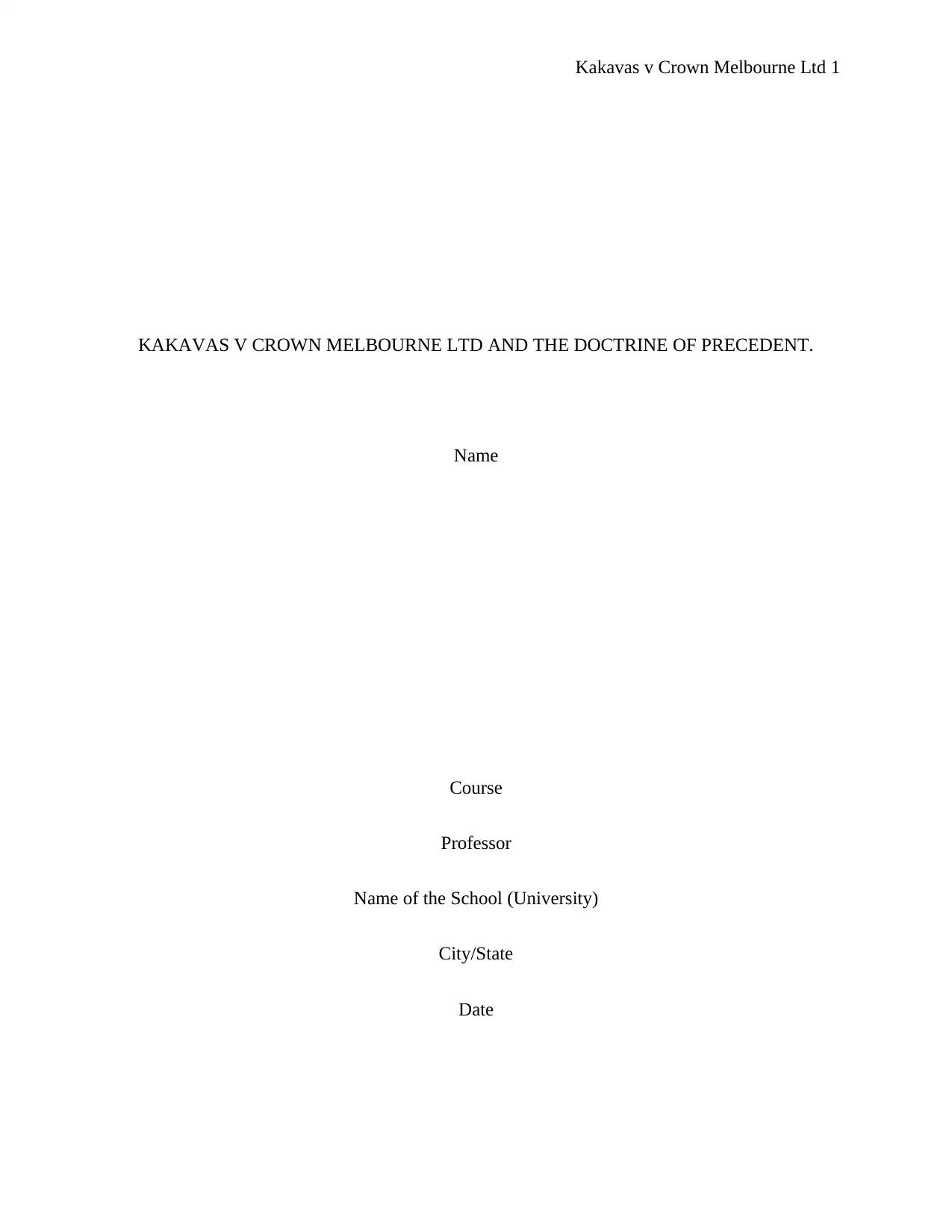
Kakavas v Crown Melbourne Ltd 1
KAKAVAS V CROWN MELBOURNE LTD AND THE DOCTRINE OF PRECEDENT.
Name
Course
Professor
Name of the School (University)
City/State
Date
KAKAVAS V CROWN MELBOURNE LTD AND THE DOCTRINE OF PRECEDENT.
Name
Course
Professor
Name of the School (University)
City/State
Date
Paraphrase This Document
Need a fresh take? Get an instant paraphrase of this document with our AI Paraphraser
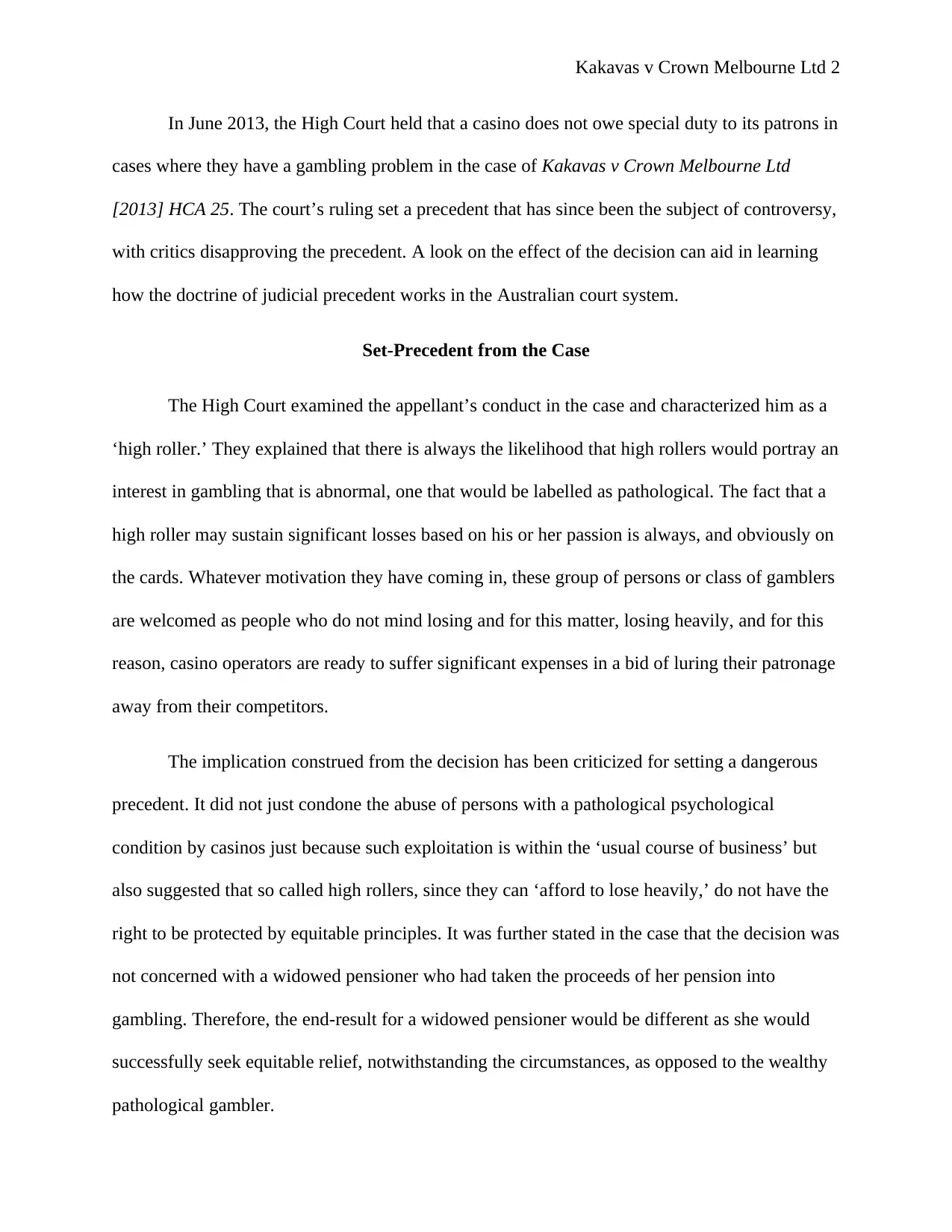
Kakavas v Crown Melbourne Ltd 2
In June 2013, the High Court held that a casino does not owe special duty to its patrons in
cases where they have a gambling problem in the case of Kakavas v Crown Melbourne Ltd
[2013] HCA 25. The court’s ruling set a precedent that has since been the subject of controversy,
with critics disapproving the precedent. A look on the effect of the decision can aid in learning
how the doctrine of judicial precedent works in the Australian court system.
Set-Precedent from the Case
The High Court examined the appellant’s conduct in the case and characterized him as a
‘high roller.’ They explained that there is always the likelihood that high rollers would portray an
interest in gambling that is abnormal, one that would be labelled as pathological. The fact that a
high roller may sustain significant losses based on his or her passion is always, and obviously on
the cards. Whatever motivation they have coming in, these group of persons or class of gamblers
are welcomed as people who do not mind losing and for this matter, losing heavily, and for this
reason, casino operators are ready to suffer significant expenses in a bid of luring their patronage
away from their competitors.
The implication construed from the decision has been criticized for setting a dangerous
precedent. It did not just condone the abuse of persons with a pathological psychological
condition by casinos just because such exploitation is within the ‘usual course of business’ but
also suggested that so called high rollers, since they can ‘afford to lose heavily,’ do not have the
right to be protected by equitable principles. It was further stated in the case that the decision was
not concerned with a widowed pensioner who had taken the proceeds of her pension into
gambling. Therefore, the end-result for a widowed pensioner would be different as she would
successfully seek equitable relief, notwithstanding the circumstances, as opposed to the wealthy
pathological gambler.
In June 2013, the High Court held that a casino does not owe special duty to its patrons in
cases where they have a gambling problem in the case of Kakavas v Crown Melbourne Ltd
[2013] HCA 25. The court’s ruling set a precedent that has since been the subject of controversy,
with critics disapproving the precedent. A look on the effect of the decision can aid in learning
how the doctrine of judicial precedent works in the Australian court system.
Set-Precedent from the Case
The High Court examined the appellant’s conduct in the case and characterized him as a
‘high roller.’ They explained that there is always the likelihood that high rollers would portray an
interest in gambling that is abnormal, one that would be labelled as pathological. The fact that a
high roller may sustain significant losses based on his or her passion is always, and obviously on
the cards. Whatever motivation they have coming in, these group of persons or class of gamblers
are welcomed as people who do not mind losing and for this matter, losing heavily, and for this
reason, casino operators are ready to suffer significant expenses in a bid of luring their patronage
away from their competitors.
The implication construed from the decision has been criticized for setting a dangerous
precedent. It did not just condone the abuse of persons with a pathological psychological
condition by casinos just because such exploitation is within the ‘usual course of business’ but
also suggested that so called high rollers, since they can ‘afford to lose heavily,’ do not have the
right to be protected by equitable principles. It was further stated in the case that the decision was
not concerned with a widowed pensioner who had taken the proceeds of her pension into
gambling. Therefore, the end-result for a widowed pensioner would be different as she would
successfully seek equitable relief, notwithstanding the circumstances, as opposed to the wealthy
pathological gambler.

Kakavas v Crown Melbourne Ltd 3
The Operation of the Precedent set by the Case
The doctrine of precedent requires judges to pay proper respect to decisions made in the
past when deciding cases. The rationale behind this is to ensure four advantages realized in
Telstra v Treloar (2000) 102 FCR 595, 602) namely certainty, efficiency, equality and the
appearance of justice on the issues brought before the court (The WritePass Journal, 2014).
There is a need to ensure that development of legal principles is fashioned in an incremental and
orderly manner (Gerhardt, 2011). Therefore, consistency is crucial, while also building faith in
the judicial system based on the four advantages is key to the success of judicial decision
making. It is highly likely that a dangerous precedent will have negative consequences on future
decisions and direly incriminate the reputation of the courts. From the foregoing case of Kakavas
v Crown Melbourne Ltd [2013] HCA 25, three questions are of significance since the set
precedence has been criticized and termed dangerous. First is when and why would the high
court decline to follow this decision, secondly is the implication of the precedent set by the case
for state and territory courts (more specifically, the Northern Territory Supreme Court) and
finally, the possibility of the decision being overruled.
When and Why the High Court Would Decline to Follow this Decision
The general rule is that the High Court is not restricted to follow decisions it made in the
past, but ordinarily, it does so if the cases are raising similar facts (Lindsay, 2017). . It is most
likely that the High Court will always follow the reasoning in the case of Kakavas v Crown
Melbourne Ltd for similar cases brought before it. However, it may also opt to walk from the
reasoning. In the case of Imbree v McNeilly [2008] HCA 40, the High Court opted not to follow
a precedent set by a previous case of Cook v Cook [1986] HCA 73, which had similar facts. In
the latter case, the high court had ruled that a driver providing learning services owed a
The Operation of the Precedent set by the Case
The doctrine of precedent requires judges to pay proper respect to decisions made in the
past when deciding cases. The rationale behind this is to ensure four advantages realized in
Telstra v Treloar (2000) 102 FCR 595, 602) namely certainty, efficiency, equality and the
appearance of justice on the issues brought before the court (The WritePass Journal, 2014).
There is a need to ensure that development of legal principles is fashioned in an incremental and
orderly manner (Gerhardt, 2011). Therefore, consistency is crucial, while also building faith in
the judicial system based on the four advantages is key to the success of judicial decision
making. It is highly likely that a dangerous precedent will have negative consequences on future
decisions and direly incriminate the reputation of the courts. From the foregoing case of Kakavas
v Crown Melbourne Ltd [2013] HCA 25, three questions are of significance since the set
precedence has been criticized and termed dangerous. First is when and why would the high
court decline to follow this decision, secondly is the implication of the precedent set by the case
for state and territory courts (more specifically, the Northern Territory Supreme Court) and
finally, the possibility of the decision being overruled.
When and Why the High Court Would Decline to Follow this Decision
The general rule is that the High Court is not restricted to follow decisions it made in the
past, but ordinarily, it does so if the cases are raising similar facts (Lindsay, 2017). . It is most
likely that the High Court will always follow the reasoning in the case of Kakavas v Crown
Melbourne Ltd for similar cases brought before it. However, it may also opt to walk from the
reasoning. In the case of Imbree v McNeilly [2008] HCA 40, the High Court opted not to follow
a precedent set by a previous case of Cook v Cook [1986] HCA 73, which had similar facts. In
the latter case, the high court had ruled that a driver providing learning services owed a
You're viewing a preview
Unlock full access by subscribing today!
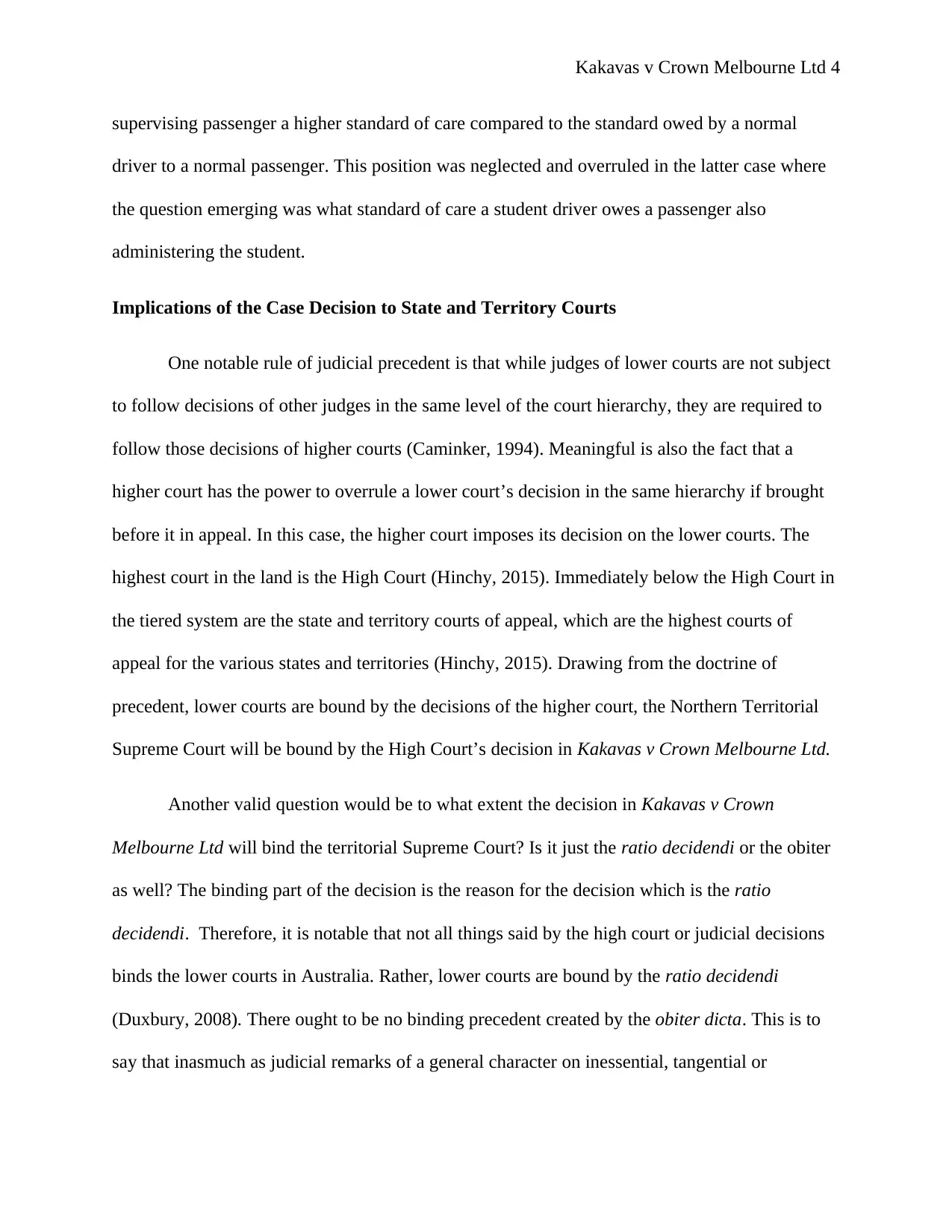
Kakavas v Crown Melbourne Ltd 4
supervising passenger a higher standard of care compared to the standard owed by a normal
driver to a normal passenger. This position was neglected and overruled in the latter case where
the question emerging was what standard of care a student driver owes a passenger also
administering the student.
Implications of the Case Decision to State and Territory Courts
One notable rule of judicial precedent is that while judges of lower courts are not subject
to follow decisions of other judges in the same level of the court hierarchy, they are required to
follow those decisions of higher courts (Caminker, 1994). Meaningful is also the fact that a
higher court has the power to overrule a lower court’s decision in the same hierarchy if brought
before it in appeal. In this case, the higher court imposes its decision on the lower courts. The
highest court in the land is the High Court (Hinchy, 2015). Immediately below the High Court in
the tiered system are the state and territory courts of appeal, which are the highest courts of
appeal for the various states and territories (Hinchy, 2015). Drawing from the doctrine of
precedent, lower courts are bound by the decisions of the higher court, the Northern Territorial
Supreme Court will be bound by the High Court’s decision in Kakavas v Crown Melbourne Ltd.
Another valid question would be to what extent the decision in Kakavas v Crown
Melbourne Ltd will bind the territorial Supreme Court? Is it just the ratio decidendi or the obiter
as well? The binding part of the decision is the reason for the decision which is the ratio
decidendi. Therefore, it is notable that not all things said by the high court or judicial decisions
binds the lower courts in Australia. Rather, lower courts are bound by the ratio decidendi
(Duxbury, 2008). There ought to be no binding precedent created by the obiter dicta. This is to
say that inasmuch as judicial remarks of a general character on inessential, tangential or
supervising passenger a higher standard of care compared to the standard owed by a normal
driver to a normal passenger. This position was neglected and overruled in the latter case where
the question emerging was what standard of care a student driver owes a passenger also
administering the student.
Implications of the Case Decision to State and Territory Courts
One notable rule of judicial precedent is that while judges of lower courts are not subject
to follow decisions of other judges in the same level of the court hierarchy, they are required to
follow those decisions of higher courts (Caminker, 1994). Meaningful is also the fact that a
higher court has the power to overrule a lower court’s decision in the same hierarchy if brought
before it in appeal. In this case, the higher court imposes its decision on the lower courts. The
highest court in the land is the High Court (Hinchy, 2015). Immediately below the High Court in
the tiered system are the state and territory courts of appeal, which are the highest courts of
appeal for the various states and territories (Hinchy, 2015). Drawing from the doctrine of
precedent, lower courts are bound by the decisions of the higher court, the Northern Territorial
Supreme Court will be bound by the High Court’s decision in Kakavas v Crown Melbourne Ltd.
Another valid question would be to what extent the decision in Kakavas v Crown
Melbourne Ltd will bind the territorial Supreme Court? Is it just the ratio decidendi or the obiter
as well? The binding part of the decision is the reason for the decision which is the ratio
decidendi. Therefore, it is notable that not all things said by the high court or judicial decisions
binds the lower courts in Australia. Rather, lower courts are bound by the ratio decidendi
(Duxbury, 2008). There ought to be no binding precedent created by the obiter dicta. This is to
say that inasmuch as judicial remarks of a general character on inessential, tangential or
Paraphrase This Document
Need a fresh take? Get an instant paraphrase of this document with our AI Paraphraser
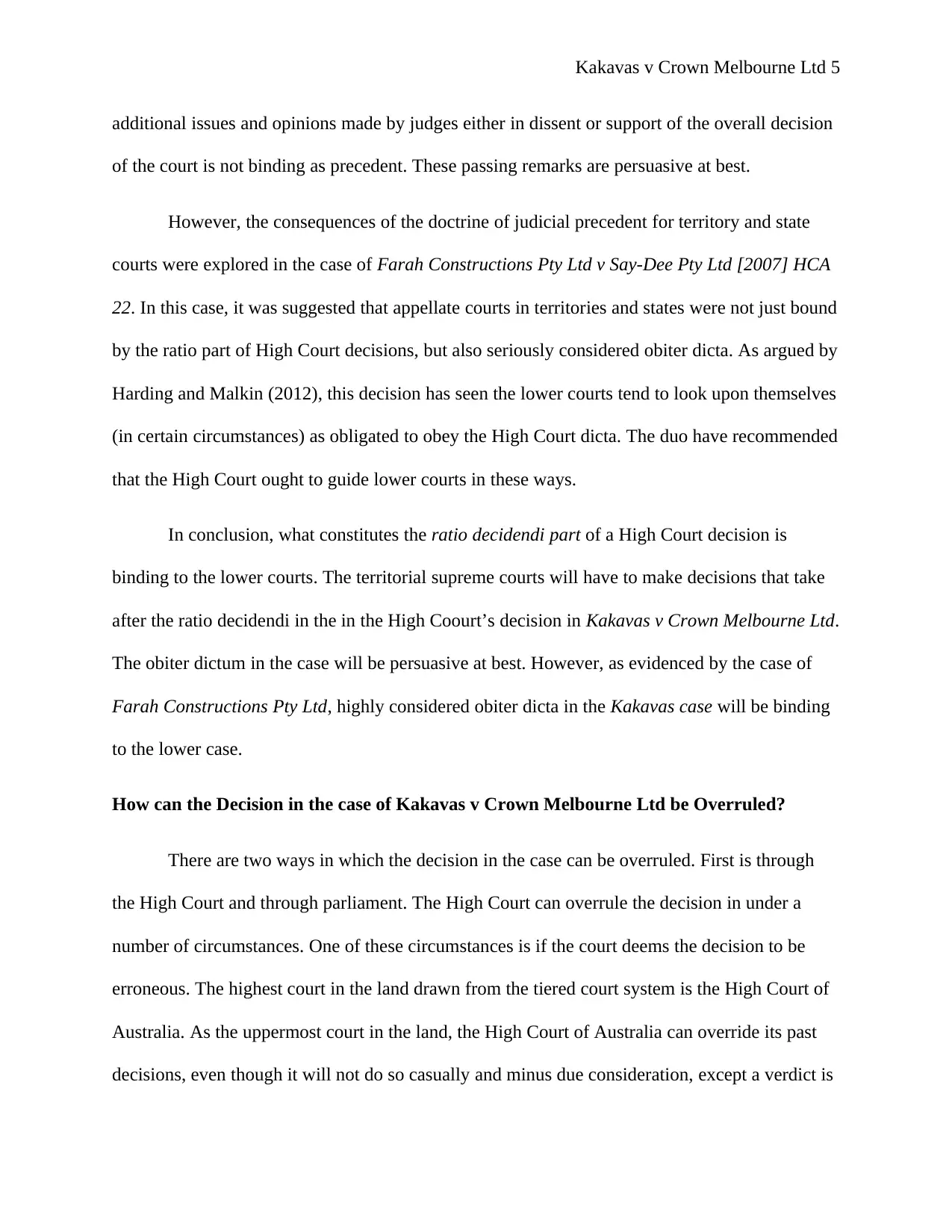
Kakavas v Crown Melbourne Ltd 5
additional issues and opinions made by judges either in dissent or support of the overall decision
of the court is not binding as precedent. These passing remarks are persuasive at best.
However, the consequences of the doctrine of judicial precedent for territory and state
courts were explored in the case of Farah Constructions Pty Ltd v Say-Dee Pty Ltd [2007] HCA
22. In this case, it was suggested that appellate courts in territories and states were not just bound
by the ratio part of High Court decisions, but also seriously considered obiter dicta. As argued by
Harding and Malkin (2012), this decision has seen the lower courts tend to look upon themselves
(in certain circumstances) as obligated to obey the High Court dicta. The duo have recommended
that the High Court ought to guide lower courts in these ways.
In conclusion, what constitutes the ratio decidendi part of a High Court decision is
binding to the lower courts. The territorial supreme courts will have to make decisions that take
after the ratio decidendi in the in the High Coourt’s decision in Kakavas v Crown Melbourne Ltd.
The obiter dictum in the case will be persuasive at best. However, as evidenced by the case of
Farah Constructions Pty Ltd, highly considered obiter dicta in the Kakavas case will be binding
to the lower case.
How can the Decision in the case of Kakavas v Crown Melbourne Ltd be Overruled?
There are two ways in which the decision in the case can be overruled. First is through
the High Court and through parliament. The High Court can overrule the decision in under a
number of circumstances. One of these circumstances is if the court deems the decision to be
erroneous. The highest court in the land drawn from the tiered court system is the High Court of
Australia. As the uppermost court in the land, the High Court of Australia can override its past
decisions, even though it will not do so casually and minus due consideration, except a verdict is
additional issues and opinions made by judges either in dissent or support of the overall decision
of the court is not binding as precedent. These passing remarks are persuasive at best.
However, the consequences of the doctrine of judicial precedent for territory and state
courts were explored in the case of Farah Constructions Pty Ltd v Say-Dee Pty Ltd [2007] HCA
22. In this case, it was suggested that appellate courts in territories and states were not just bound
by the ratio part of High Court decisions, but also seriously considered obiter dicta. As argued by
Harding and Malkin (2012), this decision has seen the lower courts tend to look upon themselves
(in certain circumstances) as obligated to obey the High Court dicta. The duo have recommended
that the High Court ought to guide lower courts in these ways.
In conclusion, what constitutes the ratio decidendi part of a High Court decision is
binding to the lower courts. The territorial supreme courts will have to make decisions that take
after the ratio decidendi in the in the High Coourt’s decision in Kakavas v Crown Melbourne Ltd.
The obiter dictum in the case will be persuasive at best. However, as evidenced by the case of
Farah Constructions Pty Ltd, highly considered obiter dicta in the Kakavas case will be binding
to the lower case.
How can the Decision in the case of Kakavas v Crown Melbourne Ltd be Overruled?
There are two ways in which the decision in the case can be overruled. First is through
the High Court and through parliament. The High Court can overrule the decision in under a
number of circumstances. One of these circumstances is if the court deems the decision to be
erroneous. The highest court in the land drawn from the tiered court system is the High Court of
Australia. As the uppermost court in the land, the High Court of Australia can override its past
decisions, even though it will not do so casually and minus due consideration, except a verdict is
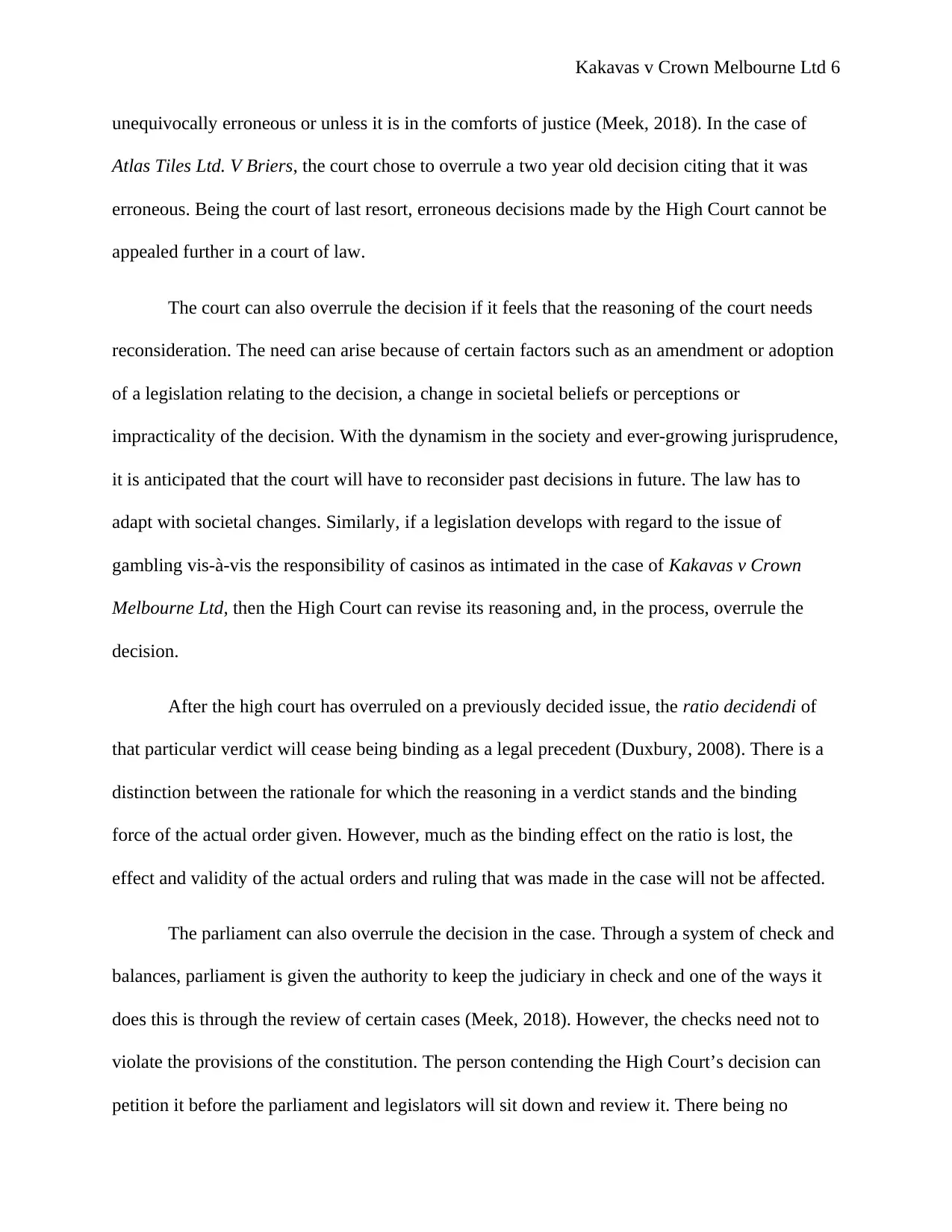
Kakavas v Crown Melbourne Ltd 6
unequivocally erroneous or unless it is in the comforts of justice (Meek, 2018). In the case of
Atlas Tiles Ltd. V Briers, the court chose to overrule a two year old decision citing that it was
erroneous. Being the court of last resort, erroneous decisions made by the High Court cannot be
appealed further in a court of law.
The court can also overrule the decision if it feels that the reasoning of the court needs
reconsideration. The need can arise because of certain factors such as an amendment or adoption
of a legislation relating to the decision, a change in societal beliefs or perceptions or
impracticality of the decision. With the dynamism in the society and ever-growing jurisprudence,
it is anticipated that the court will have to reconsider past decisions in future. The law has to
adapt with societal changes. Similarly, if a legislation develops with regard to the issue of
gambling vis-à-vis the responsibility of casinos as intimated in the case of Kakavas v Crown
Melbourne Ltd, then the High Court can revise its reasoning and, in the process, overrule the
decision.
After the high court has overruled on a previously decided issue, the ratio decidendi of
that particular verdict will cease being binding as a legal precedent (Duxbury, 2008). There is a
distinction between the rationale for which the reasoning in a verdict stands and the binding
force of the actual order given. However, much as the binding effect on the ratio is lost, the
effect and validity of the actual orders and ruling that was made in the case will not be affected.
The parliament can also overrule the decision in the case. Through a system of check and
balances, parliament is given the authority to keep the judiciary in check and one of the ways it
does this is through the review of certain cases (Meek, 2018). However, the checks need not to
violate the provisions of the constitution. The person contending the High Court’s decision can
petition it before the parliament and legislators will sit down and review it. There being no
unequivocally erroneous or unless it is in the comforts of justice (Meek, 2018). In the case of
Atlas Tiles Ltd. V Briers, the court chose to overrule a two year old decision citing that it was
erroneous. Being the court of last resort, erroneous decisions made by the High Court cannot be
appealed further in a court of law.
The court can also overrule the decision if it feels that the reasoning of the court needs
reconsideration. The need can arise because of certain factors such as an amendment or adoption
of a legislation relating to the decision, a change in societal beliefs or perceptions or
impracticality of the decision. With the dynamism in the society and ever-growing jurisprudence,
it is anticipated that the court will have to reconsider past decisions in future. The law has to
adapt with societal changes. Similarly, if a legislation develops with regard to the issue of
gambling vis-à-vis the responsibility of casinos as intimated in the case of Kakavas v Crown
Melbourne Ltd, then the High Court can revise its reasoning and, in the process, overrule the
decision.
After the high court has overruled on a previously decided issue, the ratio decidendi of
that particular verdict will cease being binding as a legal precedent (Duxbury, 2008). There is a
distinction between the rationale for which the reasoning in a verdict stands and the binding
force of the actual order given. However, much as the binding effect on the ratio is lost, the
effect and validity of the actual orders and ruling that was made in the case will not be affected.
The parliament can also overrule the decision in the case. Through a system of check and
balances, parliament is given the authority to keep the judiciary in check and one of the ways it
does this is through the review of certain cases (Meek, 2018). However, the checks need not to
violate the provisions of the constitution. The person contending the High Court’s decision can
petition it before the parliament and legislators will sit down and review it. There being no
You're viewing a preview
Unlock full access by subscribing today!
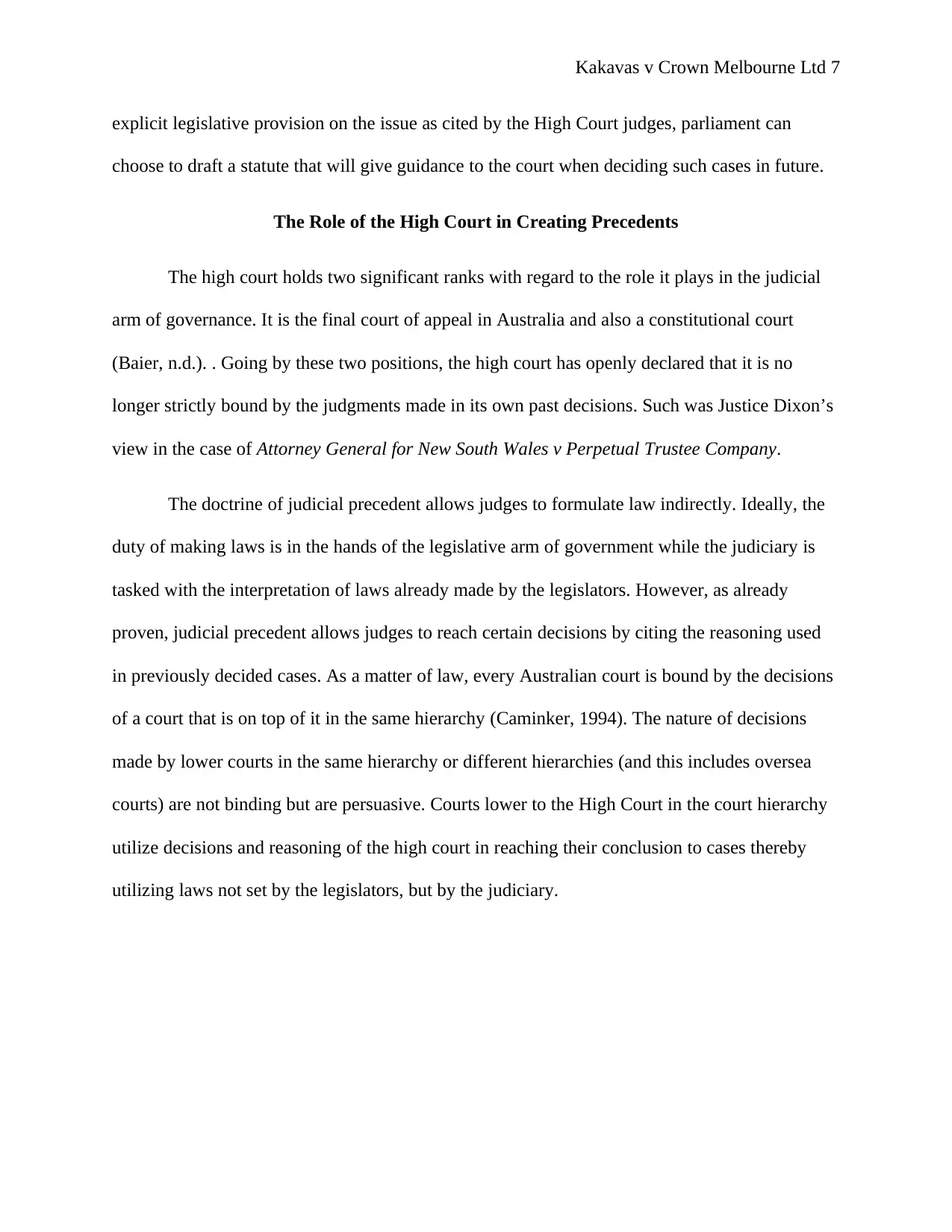
Kakavas v Crown Melbourne Ltd 7
explicit legislative provision on the issue as cited by the High Court judges, parliament can
choose to draft a statute that will give guidance to the court when deciding such cases in future.
The Role of the High Court in Creating Precedents
The high court holds two significant ranks with regard to the role it plays in the judicial
arm of governance. It is the final court of appeal in Australia and also a constitutional court
(Baier, n.d.). . Going by these two positions, the high court has openly declared that it is no
longer strictly bound by the judgments made in its own past decisions. Such was Justice Dixon’s
view in the case of Attorney General for New South Wales v Perpetual Trustee Company.
The doctrine of judicial precedent allows judges to formulate law indirectly. Ideally, the
duty of making laws is in the hands of the legislative arm of government while the judiciary is
tasked with the interpretation of laws already made by the legislators. However, as already
proven, judicial precedent allows judges to reach certain decisions by citing the reasoning used
in previously decided cases. As a matter of law, every Australian court is bound by the decisions
of a court that is on top of it in the same hierarchy (Caminker, 1994). The nature of decisions
made by lower courts in the same hierarchy or different hierarchies (and this includes oversea
courts) are not binding but are persuasive. Courts lower to the High Court in the court hierarchy
utilize decisions and reasoning of the high court in reaching their conclusion to cases thereby
utilizing laws not set by the legislators, but by the judiciary.
explicit legislative provision on the issue as cited by the High Court judges, parliament can
choose to draft a statute that will give guidance to the court when deciding such cases in future.
The Role of the High Court in Creating Precedents
The high court holds two significant ranks with regard to the role it plays in the judicial
arm of governance. It is the final court of appeal in Australia and also a constitutional court
(Baier, n.d.). . Going by these two positions, the high court has openly declared that it is no
longer strictly bound by the judgments made in its own past decisions. Such was Justice Dixon’s
view in the case of Attorney General for New South Wales v Perpetual Trustee Company.
The doctrine of judicial precedent allows judges to formulate law indirectly. Ideally, the
duty of making laws is in the hands of the legislative arm of government while the judiciary is
tasked with the interpretation of laws already made by the legislators. However, as already
proven, judicial precedent allows judges to reach certain decisions by citing the reasoning used
in previously decided cases. As a matter of law, every Australian court is bound by the decisions
of a court that is on top of it in the same hierarchy (Caminker, 1994). The nature of decisions
made by lower courts in the same hierarchy or different hierarchies (and this includes oversea
courts) are not binding but are persuasive. Courts lower to the High Court in the court hierarchy
utilize decisions and reasoning of the high court in reaching their conclusion to cases thereby
utilizing laws not set by the legislators, but by the judiciary.
Paraphrase This Document
Need a fresh take? Get an instant paraphrase of this document with our AI Paraphraser
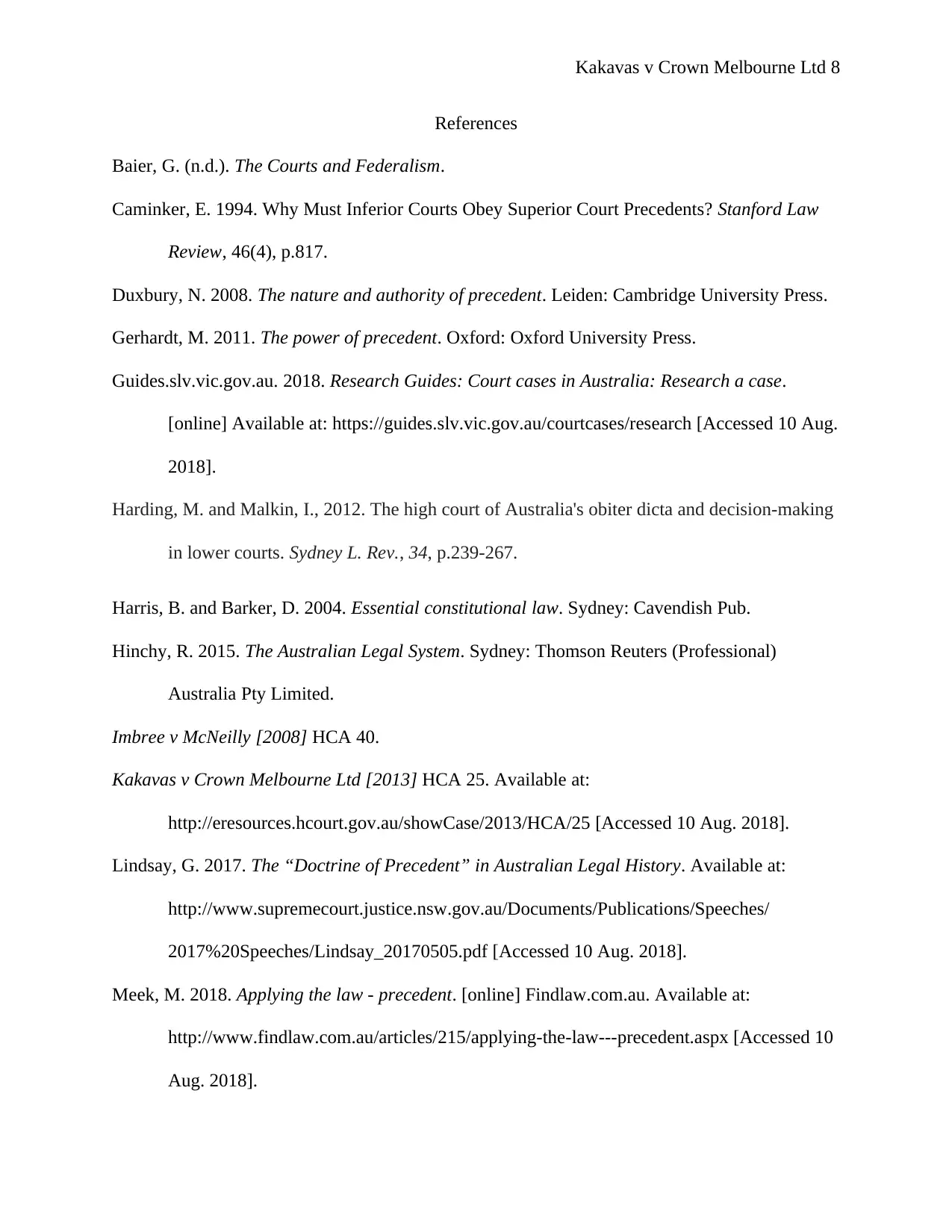
Kakavas v Crown Melbourne Ltd 8
References
Baier, G. (n.d.). The Courts and Federalism.
Caminker, E. 1994. Why Must Inferior Courts Obey Superior Court Precedents? Stanford Law
Review, 46(4), p.817.
Duxbury, N. 2008. The nature and authority of precedent. Leiden: Cambridge University Press.
Gerhardt, M. 2011. The power of precedent. Oxford: Oxford University Press.
Guides.slv.vic.gov.au. 2018. Research Guides: Court cases in Australia: Research a case.
[online] Available at: https://guides.slv.vic.gov.au/courtcases/research [Accessed 10 Aug.
2018].
Harding, M. and Malkin, I., 2012. The high court of Australia's obiter dicta and decision-making
in lower courts. Sydney L. Rev., 34, p.239-267.
Harris, B. and Barker, D. 2004. Essential constitutional law. Sydney: Cavendish Pub.
Hinchy, R. 2015. The Australian Legal System. Sydney: Thomson Reuters (Professional)
Australia Pty Limited.
Imbree v McNeilly [2008] HCA 40.
Kakavas v Crown Melbourne Ltd [2013] HCA 25. Available at:
http://eresources.hcourt.gov.au/showCase/2013/HCA/25 [Accessed 10 Aug. 2018].
Lindsay, G. 2017. The “Doctrine of Precedent” in Australian Legal History. Available at:
http://www.supremecourt.justice.nsw.gov.au/Documents/Publications/Speeches/
2017%20Speeches/Lindsay_20170505.pdf [Accessed 10 Aug. 2018].
Meek, M. 2018. Applying the law - precedent. [online] Findlaw.com.au. Available at:
http://www.findlaw.com.au/articles/215/applying-the-law---precedent.aspx [Accessed 10
Aug. 2018].
References
Baier, G. (n.d.). The Courts and Federalism.
Caminker, E. 1994. Why Must Inferior Courts Obey Superior Court Precedents? Stanford Law
Review, 46(4), p.817.
Duxbury, N. 2008. The nature and authority of precedent. Leiden: Cambridge University Press.
Gerhardt, M. 2011. The power of precedent. Oxford: Oxford University Press.
Guides.slv.vic.gov.au. 2018. Research Guides: Court cases in Australia: Research a case.
[online] Available at: https://guides.slv.vic.gov.au/courtcases/research [Accessed 10 Aug.
2018].
Harding, M. and Malkin, I., 2012. The high court of Australia's obiter dicta and decision-making
in lower courts. Sydney L. Rev., 34, p.239-267.
Harris, B. and Barker, D. 2004. Essential constitutional law. Sydney: Cavendish Pub.
Hinchy, R. 2015. The Australian Legal System. Sydney: Thomson Reuters (Professional)
Australia Pty Limited.
Imbree v McNeilly [2008] HCA 40.
Kakavas v Crown Melbourne Ltd [2013] HCA 25. Available at:
http://eresources.hcourt.gov.au/showCase/2013/HCA/25 [Accessed 10 Aug. 2018].
Lindsay, G. 2017. The “Doctrine of Precedent” in Australian Legal History. Available at:
http://www.supremecourt.justice.nsw.gov.au/Documents/Publications/Speeches/
2017%20Speeches/Lindsay_20170505.pdf [Accessed 10 Aug. 2018].
Meek, M. 2018. Applying the law - precedent. [online] Findlaw.com.au. Available at:
http://www.findlaw.com.au/articles/215/applying-the-law---precedent.aspx [Accessed 10
Aug. 2018].
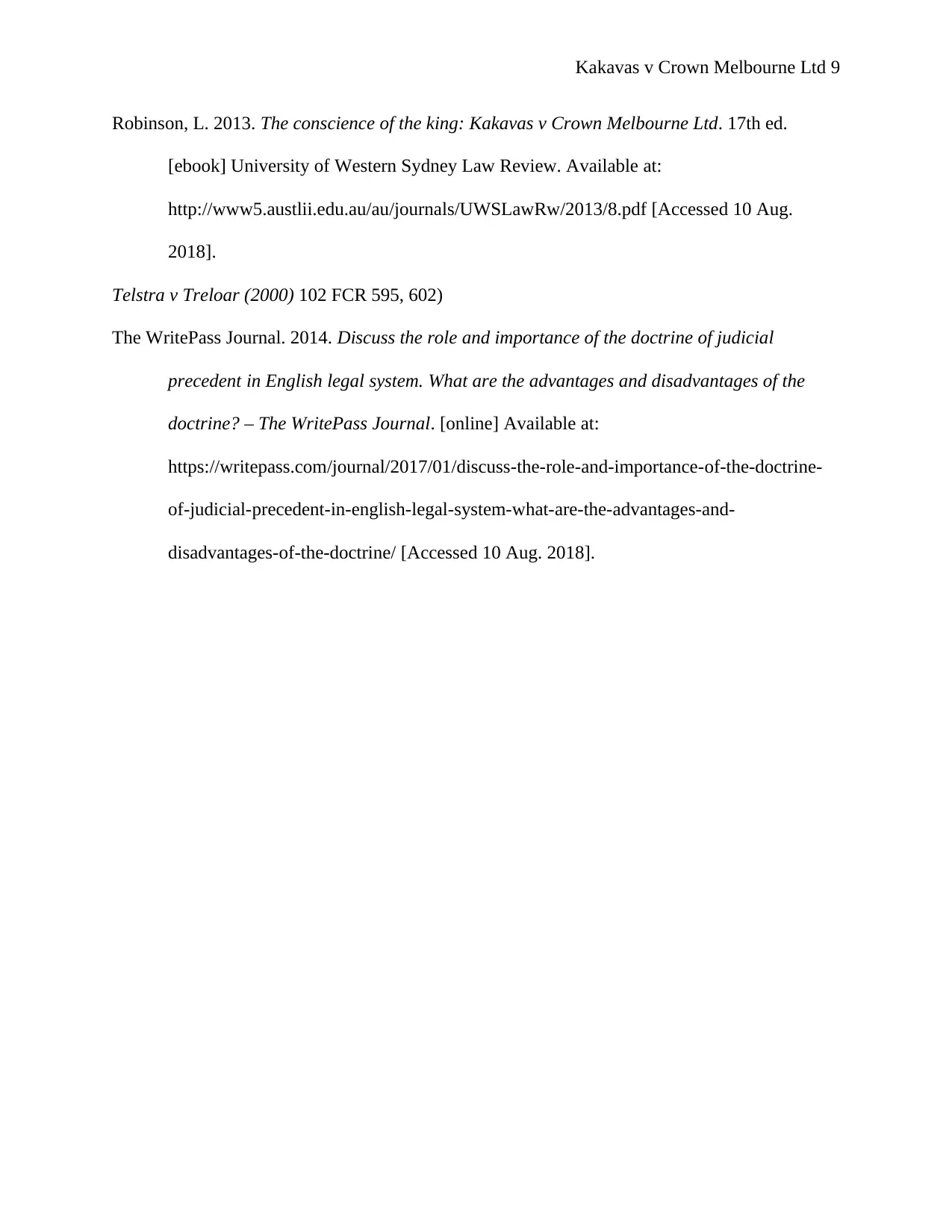
Kakavas v Crown Melbourne Ltd 9
Robinson, L. 2013. The conscience of the king: Kakavas v Crown Melbourne Ltd. 17th ed.
[ebook] University of Western Sydney Law Review. Available at:
http://www5.austlii.edu.au/au/journals/UWSLawRw/2013/8.pdf [Accessed 10 Aug.
2018].
Telstra v Treloar (2000) 102 FCR 595, 602)
The WritePass Journal. 2014. Discuss the role and importance of the doctrine of judicial
precedent in English legal system. What are the advantages and disadvantages of the
doctrine? – The WritePass Journal. [online] Available at:
https://writepass.com/journal/2017/01/discuss-the-role-and-importance-of-the-doctrine-
of-judicial-precedent-in-english-legal-system-what-are-the-advantages-and-
disadvantages-of-the-doctrine/ [Accessed 10 Aug. 2018].
Robinson, L. 2013. The conscience of the king: Kakavas v Crown Melbourne Ltd. 17th ed.
[ebook] University of Western Sydney Law Review. Available at:
http://www5.austlii.edu.au/au/journals/UWSLawRw/2013/8.pdf [Accessed 10 Aug.
2018].
Telstra v Treloar (2000) 102 FCR 595, 602)
The WritePass Journal. 2014. Discuss the role and importance of the doctrine of judicial
precedent in English legal system. What are the advantages and disadvantages of the
doctrine? – The WritePass Journal. [online] Available at:
https://writepass.com/journal/2017/01/discuss-the-role-and-importance-of-the-doctrine-
of-judicial-precedent-in-english-legal-system-what-are-the-advantages-and-
disadvantages-of-the-doctrine/ [Accessed 10 Aug. 2018].
You're viewing a preview
Unlock full access by subscribing today!
1 out of 9
Your All-in-One AI-Powered Toolkit for Academic Success.
+13062052269
info@desklib.com
Available 24*7 on WhatsApp / Email
![[object Object]](/_next/static/media/star-bottom.7253800d.svg)
Unlock your academic potential
© 2024 | Zucol Services PVT LTD | All rights reserved.


![Contract Law: Critical Analysis of Kakavas v Crown Melbourne [2013]](/_next/image/?url=https%3A%2F%2Fdesklib.com%2Fmedia%2Fimages%2Fyr%2F308a259367ea4b5d9a3e96eab87c30ee.jpg&w=256&q=75)